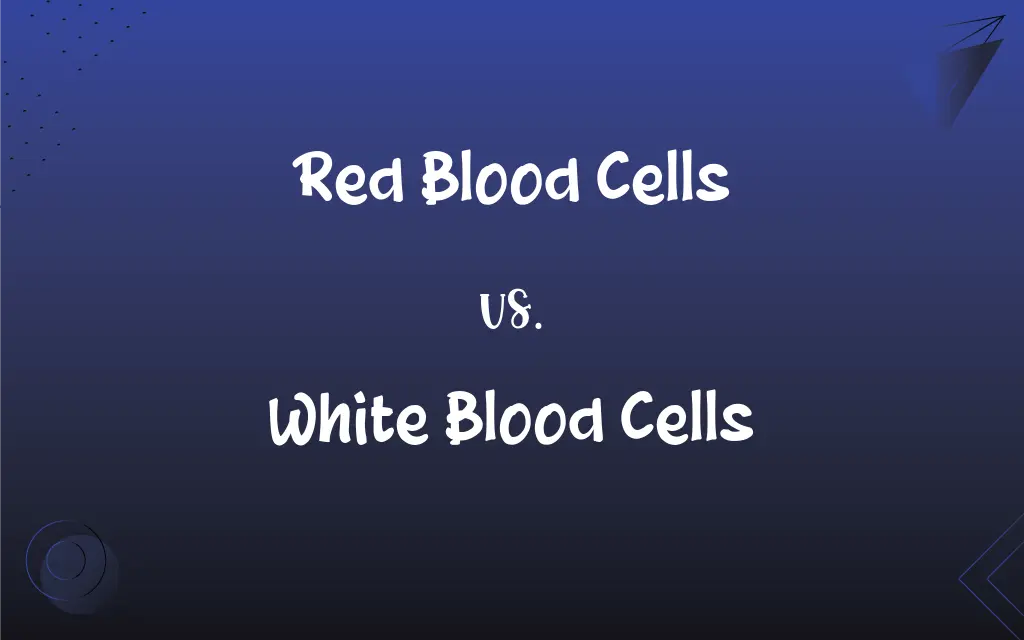Red Blood Cells vs. White Blood Cells: What's the Difference?
Edited by Aimie Carlson || By Harlon Moss || Updated on October 21, 2023
Red blood cells transport oxygen; white blood cells fight infections.

Key Differences
Red blood cells, often abbreviated as RBCs, are primarily responsible for transporting oxygen from the lungs to the rest of the body. These cells contain a protein called hemoglobin, which binds to oxygen and gives blood its red color. White blood cells, on the other hand, serve as the body's primary defense mechanism against infections. These cells are essential components of the immune system and work diligently to detect and destroy pathogens.
In the bone marrow, both red blood cells and white blood cells are produced. While red blood cells are more numerous, making up about 40-45% of blood's volume, white blood cells are fewer but extremely vital. Different types of white blood cells are designed to combat various kinds of infections and diseases. Both types of cells have limited lifespans and need to be constantly replenished.
A drop in red blood cell count can result in conditions like anemia, which leads to fatigue, shortness of breath, and paleness. Conversely, an abnormal increase or decrease in white blood cell count can be indicative of infections, bone marrow diseases, or other immune system issues. Both red blood cells and white blood cells play crucial roles in maintaining homeostasis within the body.
Examining both red blood cells and white blood cells under a microscope reveals distinct differences. Red blood cells are typically biconcave discs without a nucleus, while white blood cells are larger, have a nucleus, and can change shape. Both cell types have unique movements, with red blood cells flowing smoothly in blood vessels and white blood cells exhibiting amoeboid movement to reach infection sites.
Comparison Chart
Primary Function
Transport oxygen
Fight infections
ADVERTISEMENT
Location in Blood
More numerous (40-45%)
Fewer in number
Presence of Nucleus
No nucleus
Contains a nucleus
Lifespan
120 days
Days to years (depends on type)
Appearance under Microscope
Biconcave, no nucleus
Larger, changeable shape
Red Blood Cells and White Blood Cells Definitions
Red Blood Cells
Red blood cells are responsible for oxygen transport.
Oxygen binds to red blood cells for distribution throughout the body.
ADVERTISEMENT
White Blood Cells
White blood cells are crucial for immunity.
When an infection strikes, white blood cells are on the frontline.
Red Blood Cells
Red blood cells are biconcave discs.
When viewing a blood smear, red blood cells have a distinctive disc shape.
White Blood Cells
White blood cells contain nuclei.
Under a microscope, the nucleus is evident within white blood cells.
Red Blood Cells
Red blood cells contain hemoglobin.
Hemoglobin in red blood cells gives blood its red color.
White Blood Cells
White blood cells combat pathogens.
When bacteria invade, white blood cells swiftly act to neutralize them.
Red Blood Cells
Red blood cells originate in the bone marrow.
Bone marrow is the production site for new red blood cells.
White Blood Cells
White blood cells can change shape.
White blood cells can modify their shape to engulf harmful invaders.
Red Blood Cells
Red blood cells lack nuclei.
Unlike many cells, mature red blood cells don't have nuclei.
White Blood Cells
White blood cells are varied in types.
Different types of white blood cells respond to different threats.
FAQs
Where are both red blood cells and white blood cells produced?
Both are produced in the bone marrow.
Can white blood cells change their shape?
Yes, white blood cells can change shape to engulf and neutralize pathogens.
How do white blood cells contribute to immunity?
White blood cells detect and destroy pathogens, playing a vital role in immunity.
Why are red blood cells red?
Red blood cells contain hemoglobin, which binds to oxygen and gives them their red color.
Are white blood cells always in the same shape?
No, they can change shape to respond to threats.
Can you find both red blood cells and white blood cells in a blood sample?
Yes, both are present, with red blood cells being more numerous.
How many types of white blood cells are there?
There are five main types: neutrophils, lymphocytes, monocytes, eosinophils, and basophils.
What is the lifespan of a red blood cell?
A red blood cell typically lives for about 120 days.
Do red blood cells fight diseases?
No, that's the primary function of white blood cells.
Why are white blood cells crucial during infections?
They detect, engulf, and destroy pathogens, protecting the body.
Do white blood cells carry oxygen?
No, that's the function of red blood cells.
Do all white blood cells have the same function?
No, different types have specific roles in the immune response.
What do red blood cells primarily transport?
Red blood cells primarily transport oxygen.
Do red blood cells have a nucleus?
No, mature red blood cells lack a nucleus.
What happens if there's a drop in red blood cell count?
A drop can lead to anemia, causing symptoms like fatigue and shortness of breath.
How do red blood cells and white blood cells differ in appearance under a microscope?
Red blood cells are biconcave discs without nuclei, while white blood cells are larger, have nuclei, and can change shape.
What gives red blood cells their biconcave shape?
The absence of nuclei and specific proteins give them their distinct shape.
How do red blood cells transport oxygen?
Oxygen binds to hemoglobin within red blood cells for transport.
Why is the white blood cell count important?
It indicates the body's ability to fight infections and can signal underlying health conditions.
Why don't mature red blood cells have a nucleus?
It's expelled during maturation to maximize space for hemoglobin.
About Author
Written by
Harlon MossHarlon is a seasoned quality moderator and accomplished content writer for Difference Wiki. An alumnus of the prestigious University of California, he earned his degree in Computer Science. Leveraging his academic background, Harlon brings a meticulous and informed perspective to his work, ensuring content accuracy and excellence.
Edited by
Aimie CarlsonAimie Carlson, holding a master's degree in English literature, is a fervent English language enthusiast. She lends her writing talents to Difference Wiki, a prominent website that specializes in comparisons, offering readers insightful analyses that both captivate and inform.































































